- What Are Public Transit Apps?
- How Do Public Transit Apps Work?
- Types Of Public Transit Apps
- Must-Have Features For the Public Transit App
- Advanced Features For Public Transit App
- Technology Stack For Public Transit Apps
- Top 5 Public Transit Apps
- How to Develop a Public Transit App: A Step-by-Step Process
- Conclusion
- FAQ

In today’s fast-paced world, efficient and reliable public transportation is essential for commuters and transit authorities. As traffic congestion increases, there is a need for convenient and accessible transportation options.
In response to this demand, the public transit app development emerges as a transformative solution that leverages technology to revolutionize how people navigate and experience urban environments.
Transit application provides commuters with valuable real-time information, allowing them to check schedules, access routes, plan their journeys, and receive updates on disruptions or delays.
By leveraging the power of connectivity and smartphones, these apps offer a range of features designed to streamline user convenience and commuting experience and optimize public transportation systems.
After noticing the demand for a reliable public transportation system, developing an app for this market offers a great opportunity for investors and entrepreneurs aiming to make great returns on their investments.
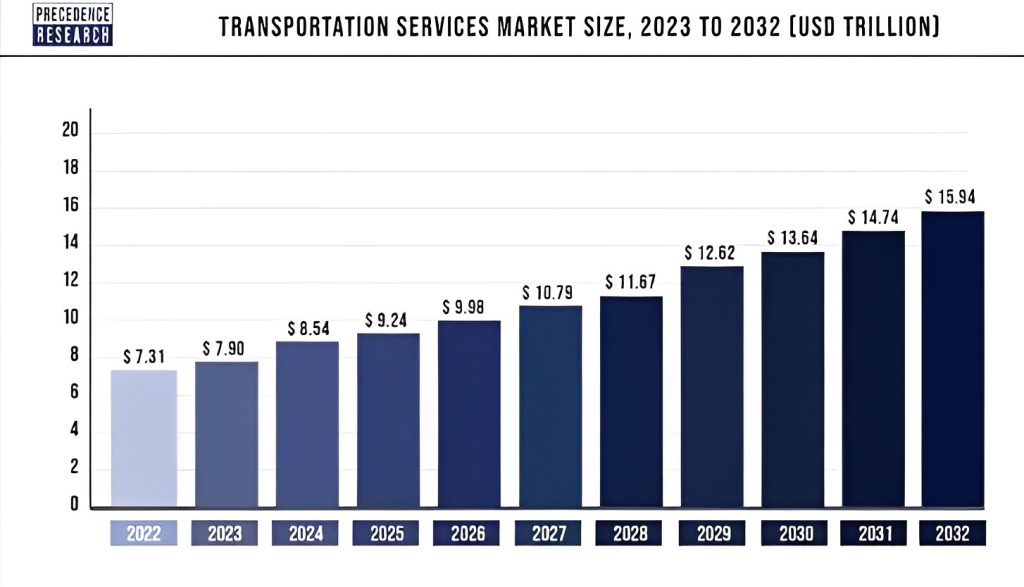
Explore the steps and must-have features to create your public transit app from scratch.
- What Are Public Transit Apps?
- How Do Public Transit Apps Work?
- Types Of Public Transit Apps
- Must-Have Features For the Public Transit App
- Advanced Features For Public Transit App
- Technology Stack For Public Transit Apps
- Top 5 Public Transit Apps
- How to Develop a Public Transit App: A Step-by-Step Process
- Conclusion
- FAQ
What Are Public Transit Apps?
A mobile application that facilitates information and assistance for the public transportation system. Public transportation applications help users to find convenient schedules for buses, fares, subways, and other forms of transportation in a specific city.
How Do Public Transit Apps Work?
Public transit app work by simplifying commuting and traveling more efficiently, convenient, and user-friendly. The application facilitates users with features such as GPS, data from transit agencies, and route schedules.
Users can better schedule their trips, avoid delays, reduce wait times, and easily navigate complex transit systems using public transit apps.
Types Of Public Transit Apps
The types of apps have been categorized below:
1. General-purpose transit apps
An urban navigation application where the app owner collaborates with different transport agencies and offers route information. Moovit is one of the best examples of a general-purpose transit app, with over 250 M users in over 3000 cities.
2. Transport Provider apps
Applications are developed based on the requirements of different transport agencies. The applications facilitate essential features to users such as information for trip planning, an online ticket purchasing system, search for routes, etc.
3. Hip-on, hop-off tour apps
A straightforward operating model where the applications are designed to ease the bus tours within the city or country. Each tour is designed with famous landmarks covering several places interesting for tourists.
Passengers and tourists can explore famous landmarks mentioned in the app and deliver the required information and features such as stops, offline city maps, audio guides, live vehicle locations, etc.
Must-Have Features For the Public Transit App
Explore the essential features of the public transit app.
I. User Panel
The following features will be accessible to the users
1. Login
A feature that allows users to register with their social media or email account credentials.
2. Location map view
The location feature is valuable for users to track the location of trains, buses, or metros at their convenience with the help of integrated maps into the app.
3. Search nearby transport mode
Users can find nearby modes of transportation, such as buses, taxis, etc, that are available. The multiple modes of transportation will simplify the users to select the best one that fits their budgets and needs.
Know how to build your cab booking app.
4. Select the pickup and drop-off location
The features will enable users to select drop-off and pick-up locations, check the mode of transportation, such as trains, buses, and metros, and select the suitable one that covers the drop-off and pick-up locations of the users.
5. Find the nearby distance and the pickup time
Users may check the pick up time and when the buses, trains, or metros are scheduled to depart from their neighboring places.
6. Add /save your favorite location
Users can save their favorite locations and accordingly select the required transportation modes with a convenient approach.
7. Estimated fare with each transportation mode
Users can estimate the fair ride according to their destinations and will be associated with the transportation modes they select.
8. Push notification
The future will notify people with different statuses, such as alerting them before the arrival of buses or other vehicles at their stop, When their drop-off location is nearby, and much more.
9. Social Media Integration
Social media will enable users to register to the platform by allowing the app to access their social media details, such as their name and e-mail address.
Also, the user can share schedules on social media with the people they are connected with on their social media accounts.
10. Ride history
A valuable feature for users to find out out the most appropriate transportation modes and cost-effective rides by accessing their past traveling history within the app.
13. Rate Drivers
The feature will enable users to rate the drivers on various parameters such as behavior, driving skills, etc.
II. Admin App
The owner of the app will access the following features.
1. Login
The feature is similar to the user section. The registration feature will help the admin create their profile on the app and manage the overall operations on their public transport app platform.
2. View on-line passengers
The feature will enable the admin to access online passengers looking for different transportation modes of services.
3. List of service providers
The admin can monitor the providers of different modes of transportation, such as trains, buses, etc., with their route in formation, vehicle working status, and all other related detail.
4. Subscription management
If the app provides premium subscriptions with the help of subscription plans, then the admin can manage their subscription with this feature.
5. Send push notifications
Admins can notify their app users about the availability of vehicles such as buses, metro, trains, and their estimated fares, ticket booking confirmability, etc.
6. Real-time vehicle tracking
Admins can track the real-time location of the vehicles and forward them to the app users who requested them in the app. The admin can profile necessary tracking information, such as estimated arrival time for reaching the particular location.
7. Update Vehicle status BUSY/AVAILABLE
The admin can enlist the availability of seats and can update the status in case of the vehicles (regarding any mode of transportation) are overloaded with passengers.
8. Control API keys
The API facilitates users with third-party features such as payment processing, location tracking, etc. Controlling API keys enables admins to manage API keys all in one place to avoid any kind of security threats and to maintain and upgrade API’s security.
Advanced Features For Public Transit App
Explore advanced features to stay competitive in the market
1. Make your journey layout
Users can submit their pick-up and drop-off location along with estimated ride costs with the help of the journey layout feature. The users can select the most suitable mode of transportation option to reach their desired destination based on many factors, such as estimated cost and time to reach their desired location.
2. In-route alerts
Users can submit their pick-up and drop-off location along with estimated ride costs with the help of the journey layout feature. The users can select the most suitable mode of transportation option to reach their desired destination based on many factors, such as estimated cost and time to reach their desired location.
3. News and updates
Update your users with more recent statuses relevant to their journey, such as fair changes, undergoing construction of the roads, or additional features valuable to them for planning their journey.
4. Geo-Location
The role of geolocation cannot be missed when developing a real-time public transportation app. Add Google and Apple maps to your app to integrate the geolocation feature that delivers the most accurate information.
Technology Stack For Public Transit Apps
The creation of mobile apps can be facilitated by the technology stack, which consists of tools and technologies.
Utilizing the appropriate tools and technologies to design your app per your project requirements may be easier if you choose a reputable app development firm.
However, the following tech stack is suggested for use while creating an app for addiction treatment.
1. Push Notifications
APNS( Apple push notifications/FCM( Firebase cloud messaging)
2. Accepting payments
Braintree, Stripe & PayPal
3. Data Management
Datastax
4. Making the functionality of the app
File transfer protocol: FTP, HTTP/HTTPS
For web services communication: TCP/IP
For socket computing: RTMP
For Security: SSL/TLS
5. Cloud Environment
AWS, and Google Real-Time Analytics, Hadoop, Spark, BigData, Apache Flink, Cisco, IBM MEAN stack (MongoDB, Express JS, Angular JS, Node.js)
6. SMS, Voice and Phone Verification
Twilio, Sinch, Nexmo
7. Email and its required elements
MailChimp Integration, Mandrill,
The Universal Operating System Database: Debian, Macintosh, Ubuntu, CentOS, MongoDB, HBase, Cassandra, Postgres
Top 5 Public Transit Apps
Explore the best apps to get ideas and inspiration for developing your public transportation app.
1. Citymapper: All Your Transport
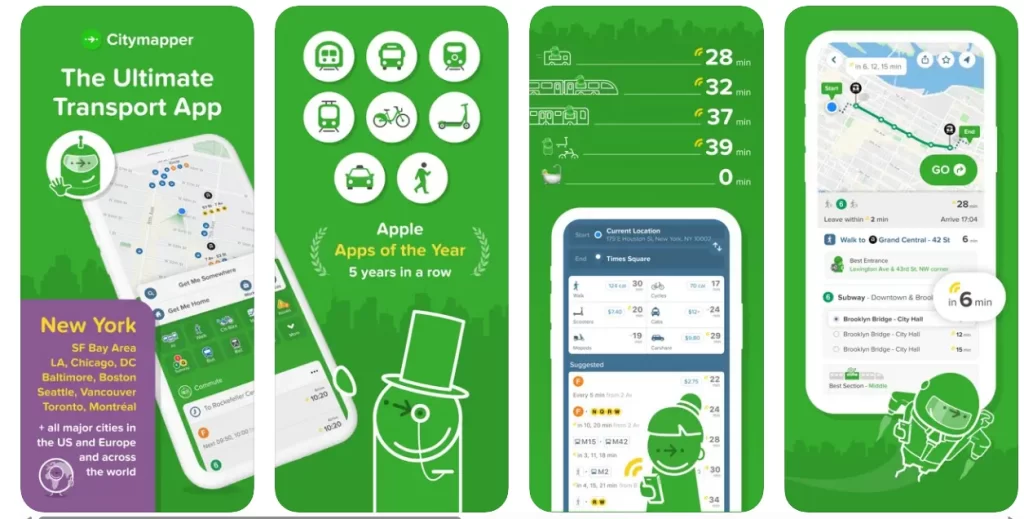
The application “Citymapper” allows users to compare different modes of transportation and then find the best routes from point A to be in a particular city.
The platform also informs its users about the direction in a turn-by-turn manner. With Citymapper, users can avoid no parking zones, checkout, wait times, fares, etc.
| Founded in | 2011 |
| Available on | Android & iOS |
| Founders | Azmat Yusuf |
| App Downloads | 10M |
| App Ratings | 4.8 |
| Headquarters | United Kingdom |
2. Whiz
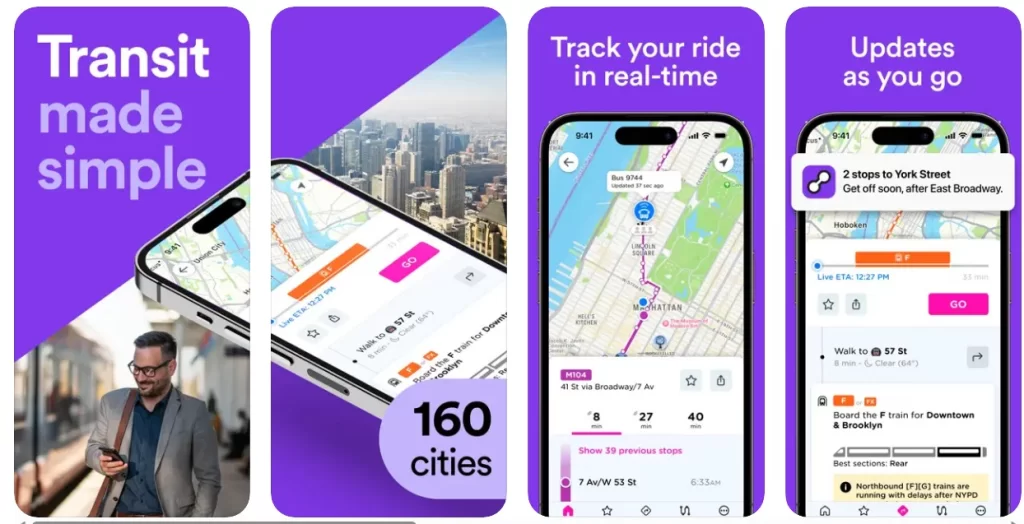
The platform provides schedules for more than 150 cities across New Zealand, the UK, Europe, America, and Australia. Whiz offers users a live journey-sharing option with friends or other contacts.
Whiz also enables their users to receive alerts when they need to have a transfer, helping them stay informed about the journey.
| Founded in | 2019 |
| Available on | Android & iOS |
| Founders | Bus Expert |
| App Downloads | 100K |
| App Ratings | 4.7 |
| Headquarters | United Kingdom |
3. ETA
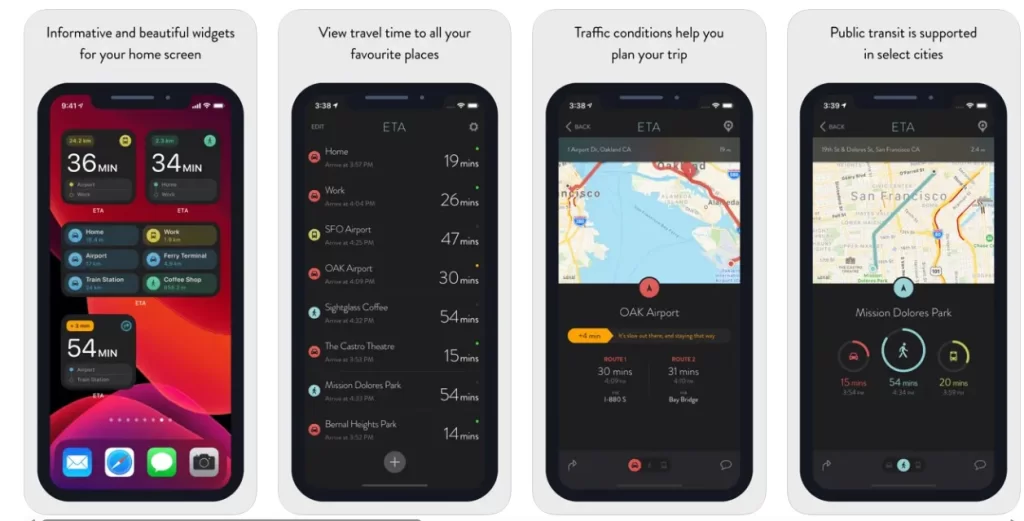
A wonderful transit app designed for mobile devices. The offer lets their users know the estimated traveling time for different modes of transportation reaching their favorite destinations.
The app also offers real-time traffic information, which helps its users to plan their trips accordingly. ETA comes with beautiful widgets that deliver information to users about their trips.
| Founded in | 2014 |
| Available on | iOS |
| Founders | Anthony Harrison and Justin Almering |
| App Downloads | N/A |
| App Ratings | N/A |
| Headquarters | Australia |
4. Transit: Bus & Subway Times
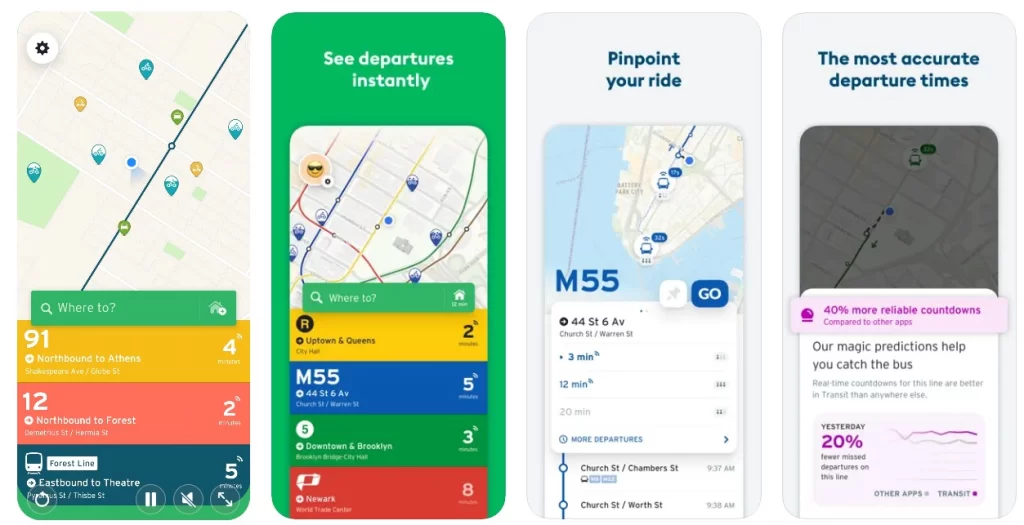
This application is best for users who regularly travel via subways or buses. The application “Transit” offers security, departure time, crowd condition, and other information to simplify the commuting experience for their users. Offering an offline schedule is one of the most remarkable features of this app.
| Founded in | 2012 |
| Available on | Android & iOS |
| Founders | Sam Vermette and Guillaume Campagna |
| App Downloads | 10M+ |
| App Ratings | 4.5 |
| Headquarters | Quebec |
5. Moovit: Bus & Train Schedules
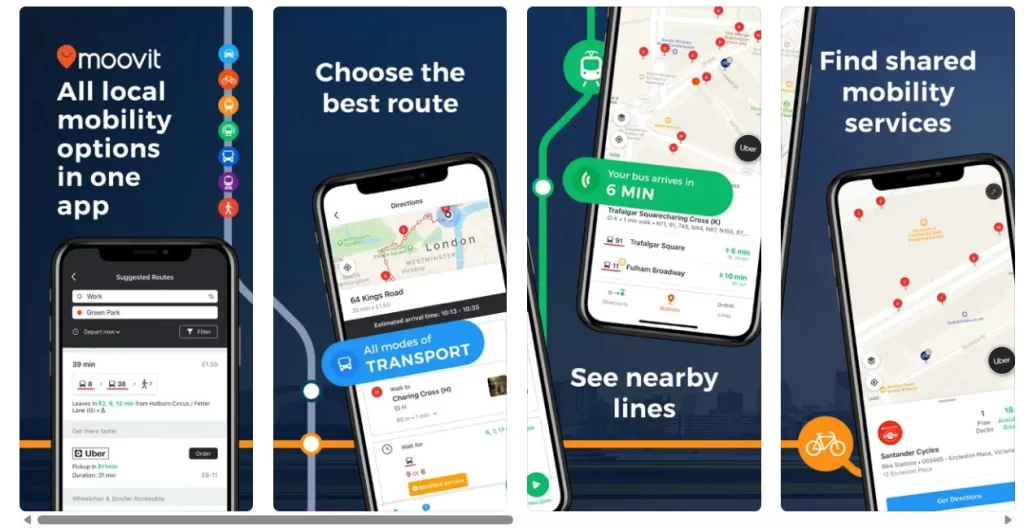
Moovit aims to deliver a one-stop travel experience to its users for getting from A to B in a particular city. The app offers accurate and efficient train and bus schedules and real-time arrival and navigation information.
This application provides information on public transport for over 3400 cities worldwide.
| Founded in | 2012 |
| Available on | Android & iOS |
| Founders | Nir Erez, Roy Bick, and Yaron Evron |
| App Downloads | 100M+ |
| App Ratings | 4.4 |
| Headquarters | Israel |
How to Develop a Public Transit App: A Step-by-Step Process
By following these steps, you can build an app that provides real-time transit information, helps users navigate routes, and enhances their overall commuting experience.
Step 1: Define the App’s Objectives and Features
Before diving into development, clearly define the objectives of your app. Identify the key features you want to offer, such as real-time arrival updates, route planning, fare information, and service alerts. Understanding your app’s purpose will guide the development process and help you prioritize features.
Step 2: Research Transit APIs
To access transit data, you’ll need to integrate with a transit API. Research available transit APIs that cover your target geographic area. Evaluate the data they provide, including routes, schedules, and real-time updates. Choose an API that best aligns with your app’s objectives and offers reliable and up-to-date information.
Step 3: Design the User Interface
Create wireframes or mockups to visualize the app’s user interface (UI). Consider the needs of your target audience and design an intuitive and visually appealing interface. Focus on simplicity and ease of use, ensuring users can quickly access the information they need.
Step 4: Gather Transit Data
Once you’ve selected a transit API, start gathering the necessary data for your app. Retrieve information such as routes, schedules, stop locations, and fare details. Store this data securely in a database or use a caching mechanism to ensure fast retrieval.
Step 5: Implement Real-Time Updates
To provide users with real-time transit information, integrate with the transit API’s real-time updates feature. This will allow your app to display accurate arrival times, service delays, and other relevant information. Implement a mechanism to regularly fetch and update this data to ensure its freshness.
Step 6: Develop Route Planning Functionality
Implement a route planning feature that helps users find the best transit routes between two locations. Use algorithms or existing libraries to calculate optimal routes based on factors like distance, travel time, and transfers. Provide users with multiple route options and include real-time data for each route.
Step 7: Incorporate User Feedback and Ratings
Allow users to provide feedback on routes, services, and overall app experience. Implement a rating and review system to collect user opinions. Analyze this feedback to identify areas for improvement and make necessary updates to enhance the app’s usability.
Step 8: Integrate Payment Options
If your app includes fare payment functionality, integrate with payment gateways or contactless payment systems. Ensure a secure and seamless payment experience for users. Implement features like ticket purchasing, mobile wallets, or integration with transit agency payment systems.
Step 9: Test and Refine the App
Thoroughly test your app across different devices, operating systems, and network conditions. Check for usability issues, performance bottlenecks, and bugs. Collect feedback from beta testers or early users to identify areas for improvement. Continuously refine the app based on user feedback and testing results.
Step 10: Launch and Promote the App
Once you’re confident in the app’s stability and functionality, prepare for its launch. Create an app store listing with engaging descriptions, screenshots, and promotional materials. Use online marketing channels, social media, and targeted advertising to promote your app to the intended audience.
Conclusion
Public transit app development is a practical step towards enhancing transportation systems and improving the overall commuting experience for individuals.
The mobile app offers numerous benefits and solutions to address transit authorities’ and commuters’ challenges.
By leveraging the capabilities of mobile devices, transportation applications can revolutionize how individuals manage their daily commutes and trips to their favorite destinations.
You may need years of programming and knowledge of the transportation industry that only a reliable app development company can have for developing your public transit app.
Connect with Idea Usher, a leading mobile app development company with over decades of experience developing and implementing the best solutions for businesses with app development. Our team has excelled in converting ideas into applications.
You can check the mobile application we have built for our client, “Share My Ride,” to get an overview of our skills and experience in creating mobile applications relevant to the industry you are interested in.
Contact us to learn more about how we can help build and launch your public transportation application.
Contact Idea Usher
Email:
Phone:
FAQ
1. What are the positive impacts of the use of apps for transportation?
A. Smartphone apps have reduced the cognitive load of static and dynamic route planning, and made it simpler and easier to pay for and access transportation (e.g., Waze, Transit App, Google Maps). They have also made accessing and sorting through complex public transit schedule data easier.
2. What are the best public transportation apps?
A. Whiz, ETA, Citymapper, Moovit, and Transit are some of the best public transit apps.
3. What is the market size of public transportation apps?
A. The global market for transport services was estimated at $7.31 trillion in 2022 and is projected to rise to $15.94 trillion by 2032, with a CAGR of 8.11% from 2023 to 2032.










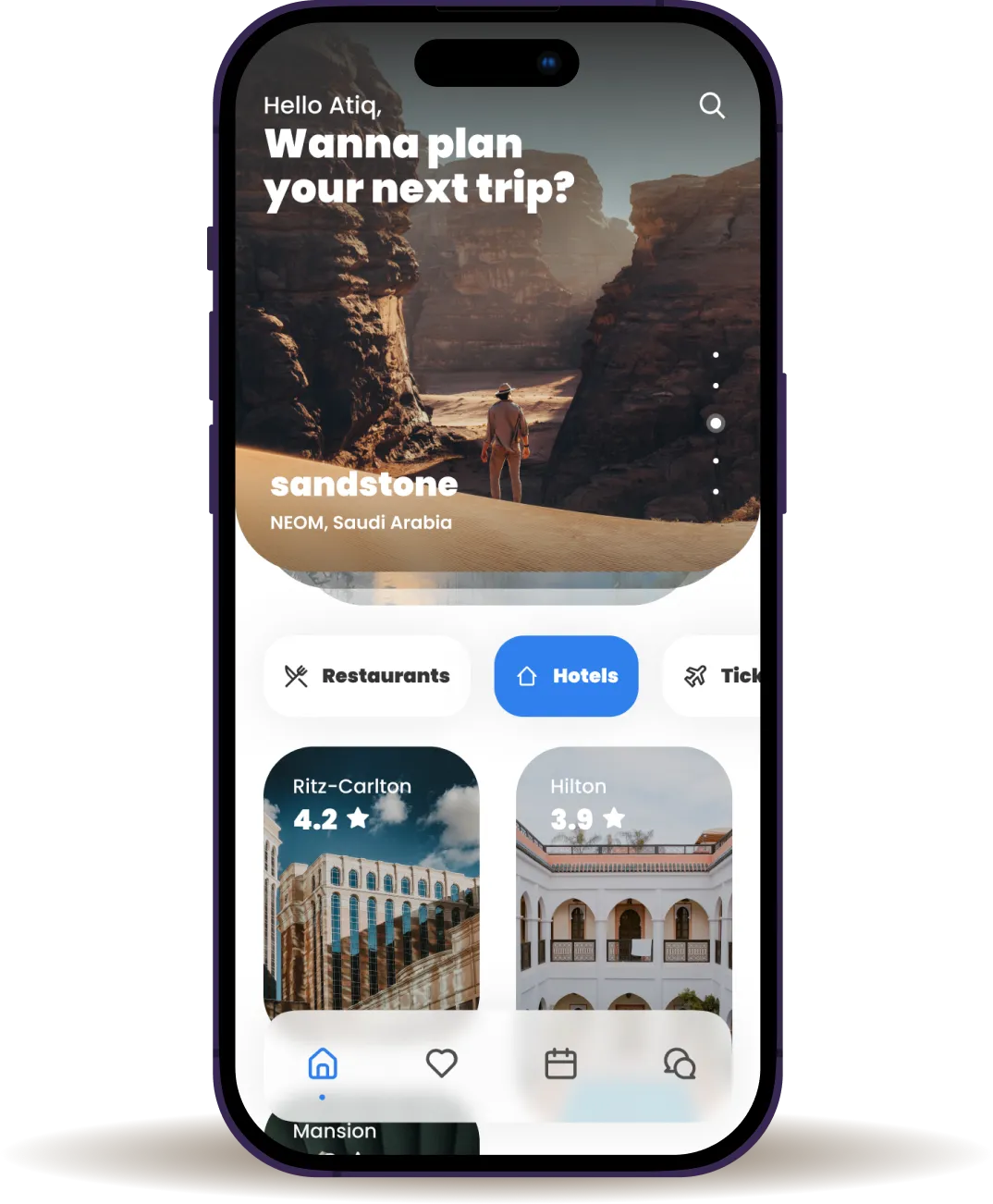


Gaurav Patil